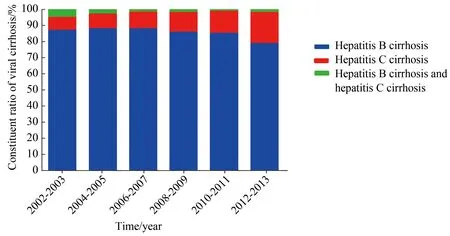中国北方地区肝硬化病因及合并症的变迁
2017-08-02丁惠国陈玉涵范春蕾董培玲
王 征 丁惠国 陈玉涵 李 磊 范春蕾 董培玲
(首都医科大学附属北京佑安医院肝病消化中心, 北京 100069)
中国北方地区肝硬化病因及合并症的变迁
王 征 丁惠国*陈玉涵 李 磊 范春蕾 董培玲
(首都医科大学附属北京佑安医院肝病消化中心, 北京 100069)
目的 阐明中国北方地区肝硬化病因及其合并症的变迁。方法 回顾性分析2002年1月1日至2013年12月31日间首次住院的肝硬化病人人口学信息及其合并症,以2年为一时间段,分析中国北方地区肝硬化病因构成及合并症的变迁。结果 12年间共12 948例肝硬化病人,其中男性8 937例(69.02%),女性4 011例(30.98%)。平均年龄(51.29±11.81)岁(7~93岁)。乙型肝炎病毒(hepatitis B virus, HBV)/丙型肝炎病毒(hepatitis C virus, HCV)相关及酒精性肝硬化以男性为主,而自身免疫性肝病所致肝硬化、药物性及非酒精脂肪性肝硬化以女性为主。住院肝硬化病人逐年增加,其病因构成变化:HBV相关肝硬化从86.72%降至78.65%(P<0.01),HCV相关肝硬化从8.07%升至19.27%(P<0.01)。酒精性、自身免疫性肝病所致肝硬化及不明原因肝硬化分别从7.68%至16.52%、2.65%至10.0%、0.72%至5.27%(P<0.01),非酒精性脂肪性肝硬化占3.76%(P<0.01)。腹水为最常见的合并症,占66.34%,单纯腹水、消化道出血构成比呈减少趋势,而2个以上合并症者呈增加趋势。结论 住院肝硬化病人逐年增加,HCV相关性、酒精性、自身免疫性肝病所致肝硬化及非酒精性脂肪性肝硬化显著增加,HBV相关肝硬化减少。腹水、消化道出血仍为主要合并症,其构成比呈逐年减少趋势。
肝硬化;病因;合并症;构成比
肝硬化是由一种或多种病因导致的以肝脏假小叶形成为病理特征的常见疾病,其临床分为I~V期[1],常以门静脉高压合并症住院。全球肝硬化的病因及合并症因地区差异而各不相同[2-6]。迄今,乙型肝炎病毒(hepatitis B virus, HBV)感染是中国及东南亚地区肝硬化的主要原因,丙型肝炎病毒(hepatitis C virus, HCV)感染是日本及欧美国家肝硬化的主要原因。本研究回顾性分析了2002年1月1日至2013年12月31日间首次住院的肝硬化病人人口学信息及其合并症,旨在阐明中国北方地区肝硬化的病因及其合并症的变迁。
1 材料和方法
1.1 病例初筛
通过首都医科大学附属北京佑安医院电子病案管理信息系统检索,筛选2002年1月1日至2013年12月31日期间,出院诊断包含“肝硬化”的全部病人。
1.2 纳入病例的标准
1)首次入院病人;2)符合肝硬化诊断标准:有明确的慢性肝病基础,伴门静脉高压的临床表现(腹水、脾大伴脾功能亢进、食管胃底静脉曲张),B超和/或CT检查符合肝硬化表现;或肝脏穿刺病理活检诊断为肝硬化;3)重复住院病人仅统计首次住院的信息; 4)排除非北方籍贯病人及明确诊断的原发性肝癌病人。
1.3 建立DataBase数据
所有病人数据来源于临床病历记录,专人统计病人的人口学信息、病因、合并症等资料。每2年为一个时间段,统计分析肝硬化病因及其合并症的变化。其中,HBV/HCV相关肝硬化病人采用随机抽样方法,每个时间段各抽取384例病人,详细核查病历记录的各项观察指标,分析HBV、HCV相关肝硬化的变化趋势。
1.4 统计学方法
采用SPSS 19.0软件包进行统计分析。计数资料以频数和百分数表示,组间比较采用χ2检验。以P<0.05为差异有统计学意义。
2 结果
2.1 一般资料
12年期间共入院肝硬化病人25 286例,剔除重复住院病人11 392例,排除外籍病人85例、南方地区861例,最终纳入统计分析的肝硬化病人12 948例。其中,男性8 937例(69.02%),女性4 011例(30.98%),男女比例2.23∶1,年龄7~93岁,平均年龄(51.29±11.81)岁,30~69岁者占89.73%,其年龄分布为正态分布,以青壮年为主(图1)。前3位的省市自治区分别为:北京籍6 471名(49.98%),河北籍2 035名(15.72%),内蒙古自治区1 016名(7.85%),详见表1。

图1 肝硬化病人年龄及性别分布

表1 北方地区肝硬化病人的地理分布
2.2 肝硬化病因构成比
12 948例肝硬化病人的病因构成比详见表2。HBV/HCV相关肝硬化病人共8 422例(65.04%),其次为酒精性肝硬化1 599例(12.35%),酒精性肝硬化合并其他原因1 607例(12.41%),自身免疫性肝病所致肝硬化780例(6.03%),非酒精性脂肪肝(1.35%),不明原因319例(2.46%)。其他原因包括心源性肝硬化16例(0.12%),药物性肝硬化 27例(0.21%),肝豆状核变性4例(0.03%)。
2.3 性别差异
酒精性及HBV/HCV感染导致的肝硬化以男性为主,分别占97.31%及 64.93%。而自身免疫性肝病所致肝硬化、药物性及非酒精性肝硬化以女性为主,分别占87.18%、59.26%及60.34 %(P<0.001)。详见表2。
2.4 肝硬化病因构成比的变化
酒精性、自身免疫性肝病所致肝硬化及不明原因肝硬化分别从7.68%增加至16.52%、2.65%至10%、0.72%至5.27%(P<0.01)。值得注意的是非酒精性脂肪性肝硬化逐年增加,占3.76%(P<0.01),见图2。HBV相关肝硬化从86.72%降至78.65%(P<0.01),HCV相关肝硬化从8.07%至19.27%(P<0.01),见图3。
2.5 肝硬化合并症的变迁
无合并症代偿期肝硬化为3 729例,占28.8%。腹水为最常见的合并症,占66.34%。其中,单纯消化道出血及肝性脑病分别占2.74%、1.72%,单纯腹水病人占43.94%,腹水伴消化道出血、肝性脑病、肝肾综合征分别占6.19%、10.07%、0.93%;腹水伴至少2个以上合并症占5.21%。不同时期肝硬化合并症的构成比也存在差异(图4)。单纯腹水及消化道出血合并症构成比有减少趋势,而伴2个以上合并症病人有增加的趋势。

图2 中国北方近12年住院肝硬化病人病因构成比变化趋势
Compared the composition ratio of cirrhotic etiologies between 2012-2013 and 2002-2003 years; HBV/HCV related cirrhosis decreased(P<0.001),alcoholic cirrhosis increased(P<0.001),alcoholic cirrhosis with other causes of cirrhosis decreased (P<0.001),nonalcoholic fatty liver cirrhosis increased(P<0.001),increased cirrhotic patients due to autoimmune liver disease(P<0.001),cryptogenic cirrhosis increased(P<0.001),rare causes of cirrhosis increased (P<0.001);HBV: hepatitis B virus; HCV:hepatitis C virus.

表2 肝硬化病人的不同病因构成及性别差异
HBV:hepatitis B virus; HCV:hepatitis C virus.

图3 中国北方近12年住院病毒性肝炎肝硬化病人构成比变化趋势
Compared the composition ratio of viral hepatitis related cirrhosis between 2012-2013 and 2002-2003 years: hepatitis B cirrhosis decreased(P<0.001),hepatitis C cirrhosis increased(P<0.001),hepatitis B and hepatitis C coinfection related cirrhosis decreased(P<0.001).

图4 中国北方近12年住院肝硬化病人合并症构成比的变化趋势
Compared the composition ratio of cirrhosis with complications between 2012-2013 and 2002-2003 years:compensated cirrhosis (no complications) increased(P<0.001),ascites decreased(P<0.001),gastrointestinal bleeding decreased(P<0.001), 2 or more complications increased(P<0.001).
3 讨论
肝硬化是临床常见病,近年来全球肝硬化发病率有增加的趋势[1]。欧美国家或地区以乙醇及HCV感染为肝硬化的主要原因[2]。Silva等[3]报道63 910例葡萄牙的肝硬化病人中,76.0%为酒精性肝硬化,而HCV、HBV感染分别占3.6%、1.1%,男性占74.4%。Qua等[4]报道马来西亚肝硬化的原因:HCV、HBV感染分别占46.1%、18.5%,不明原因肝硬化15.4%,酒精性肝硬化占12.6%。Wang等[5]回顾中国南方8 080例肝硬化病人病因中,HBV/HCV感染占80.62%,酒精性肝硬化占5.68%。Song等[6]报告北京地区2 119例肝硬化病人的病因,HBV感染占58.7%,HCV感染占7.6%;酒精性肝病为9.4%,自身免疫性肝病所致肝硬化9.4%。同时也发现,在过去的18年,HBV感染从75.2%下降到48.7%;酒精性肝病已从5.1%上升到10.6%;自身免疫性肝病所致肝硬化从2.2%上升到12.9%。本研究显示,HBV/HCV感染仍是中国北方地区肝硬化的主要原因,占65.04%。但是,近12年来,HBV相关肝硬化明显下降,而HCV相关肝硬化、酒精性、自身免疫性肝病所致肝硬化及非酒精性脂肪性肝硬化逐年增加。在中国南方,近10年酒精性肝硬化构成比无明显变化[5],而北方吉林省酒精性肝硬化从1999年的10.8%上升为2003年24.0%[7]。中国南北方肝硬化病因存在差异可能与生活及饮食习惯有关。
Michitaka等[8]通过分析日本58家医院中33 379例肝硬化病人的数据,发现在日本肝硬化病因中,自身免疫性肝病所致肝硬化占4.3%,非酒精性脂肪性肝炎病人占2.1%。我国尚仍无自身免疫性肝病所致肝硬化及非酒精性脂肪性肝硬化在肝硬化中构成比的数据。在本研究中,自身免疫性肝病所致肝硬化病人数明显增加,可能与对该病的诊断水平的提高有关。欧美国家非酒精性脂肪性肝硬化构成比为2%~6%[2,9], 在不明原因肝硬化病人中,非酒精性脂肪肝炎占60%~70%[10]。本研究显示,非酒精性脂肪性肝硬化逐年增加,可能是因为我们对此类病因的重视和认识程度明显提高。
合并症是肝硬化病人住院的主要原因。随着I、Ⅱ期肝硬化的早期发现及针对病因的有效治疗,肝硬化合并症的发生率逐年降低。本资料显示,腹水仍是最主要的合并症,占66.34%;消化道出血总构成比为13.44%,肝性脑病总构成比为17.11%。值得注意的是,近12年来,中国北方地区单纯腹水及消化道出血的构成比呈逐年减低,可能与针对乙肝肝硬化有效的抗病毒治疗及内镜治疗有关。
总之,近12年来中国北方地区住院肝硬化病人逐年增加,HBV感染肝硬化明显减少,而HCV相关肝硬化、酒精性、免疫性及非酒精性脂肪性肝硬化的构成比显著增加。腹水、消化道出血仍为主要合并症,构成比呈逐年减少趋势,而肝硬化多个合并症病人显著增加,为今后肝硬化及其合并症的防治策略提供了重要的依据。
[1] Tsochatzis E A, Bosch J, Burroughs A K. Liver cirrhosis[J]. Lancet, 2014,383(9930):1749-1761.
[2] Sivanathan V, Kittner J M, Sprinzl M F, et al. Etiology and complications of liver cirrhosis: data from a german centre[J]. Dtsch Med Wochenschr, 2014,139(36):1758-1762.
[3] Silva M J, Rosa M V, Nogueira P J, et al. Ten years of hospital admissions for liver cirrhosis in portugal[J]. Eur J Gastroenterol Hepatol, 2015,27(11):1320-1326.
[4] Qua C S, Goh K L. Liver cirrhosis in malaysia: peculiar epidemiology in a multiracial Asian country[J]. J Gastroenterol Hepatol, 2011,26(8):1333-1337.
[5] Wang X, Lin S X, Tao J, et al. Study of liver cirrhosis over ten consecutive years in Southern China[J]. World J Gastroenterol, 2014,20(37):13546-13555.
[6] Song G J, Feng B, Rao H Y, et al. Etiological features of cirrhosis inpatients in Beijing, China[J] Chin Med J (Engl), 2013,126(13):2430-2434.
[7] 刘阳, 迟宝荣. 酒精性肝硬化237例临床分析[J]. 吉林医学, 2004(04):40-42.
[8] Michitaka K, Nishiguchi S, Aoyagi Y, et al. Etiology of liver cirrhosis in Japan: a nationwide survey[J]. J Gastroenterol, 2010,45(1):86-94.
[9] Haukeland J W, Lorgen I, Schreiner L T, et al. Incidence rates and causes of cirrhosis in a Norwegian population[J]. Scand J Gastroenterol, 2007,42(12):1501-1508.
[10] Farrell G C, Larter C Z. Nonalcoholic fatty liver disease: from steatosis to cirrhosis[J]. Hepatology, 2006,43(2 Suppl 1):S99-S112.
编辑 陈瑞芳
Changes of the aetiologies of cirrhosis and its complications in north China
Wang Zheng,Ding Huiguo*,Chen Yuhan,Li Lei, Fan Chunlei,Dong Peiling
(DepartmentofGIandHepatology,BeijingYouanHospital,CapitalMedicalUniversity,Beijing100069,China)
Objective To investigate the prevalence changes of aetiologies and complications of liver cirrhosis in northern China. Methods In this retrospective study, we identified cases of the demographic information and complications of patients with cirrhosis who were firstly hospitalized between December 31, 2013 to January 1, 2002. Two years were defined as a stage, to clarify the prevalence of the etiology of cirrhosis and complications in north China. Results Total 12 948 cirrhosis inpatients were included in this study during 12 years. Of them, male was accounted 69.02% and female 30.98%. The average age of all of the patients was (51.29±11.81) years (from7 to 93 year). Hepatitis B virus/hepatitis C virus (HBV/HCV) and alcoholic liver cirrhosis were most male, and autoimmune, drug-induced and non-alcoholic related cirrhosis were predominantly female. The hospitalized patients with cirrhosis were gradually increased. HBV related cirrhosis had fallen from 86.72% to 78.65% (P<0.01), however, HCV related cirrhosis had increased from 8.07% to 19.27% (P<0.01). The alcoholic, autoimmune and cryptogenic cirrhosis were respectively increased from 7.68% to 16.52%, from 2.65% to 10.0% and from 0.72% to 5.27% (P<0.01). The non-alcoholic fatty liver cirrhosis accounted for 3.76%. Ascites is the most common complication accounted for 66.34%, simple ascites and gastrointestinal bleeding constituent ratio decreased, while more than 2 complications increased in cirrhostic patients. Conclusion Hospitalized cirrhotic patients are increased. A significant increased constituent ratio of HCV, alcoholic, autoimmune and nonalcoholic cirrhosis are observed. The constituent ratio of ascites, gastrointestinal bleeding remained a major complication, are decreased.
liver cirrhosis; etiology; complications; composition ratio
北京市医院管理局临床医学发展专项(ZYLX201610),登峰计划专项(DFL20151602),首都发展基金专项 (2014-1-2181), 佑安肝病艾滋病基金(20150103)。This study was supported by Beijing Municipal Administration of Hospitals Clinical Medicine Development of Special Funding (ZYLX201610), Beijing Municipal Administration of Hospitals’ Ascent Plan (DFL20151602), Capital Science and Technology Development Fund (2014-1-2181), Liver and AIDS Disease Fund of Beijing Youan Hospital(20150103).
时间:2017-07-16 17∶15 网络出版地址:http://kns.cnki.net/kcms/detail/11.3662.r.20170716.1715.002.html
10.3969/j.issn.1006-7795.2017.04.022]
R575.2
2017-03-20)
*Corresponding author, E-mail:dinghuiguo@ccmu.edu.cn
